仁爱版八年级上英语Unit 2 Topic 1 Section B教学设计【精校版】
Unit 2 Topic 1 Section B 教案 仁爱版八年级英语上册
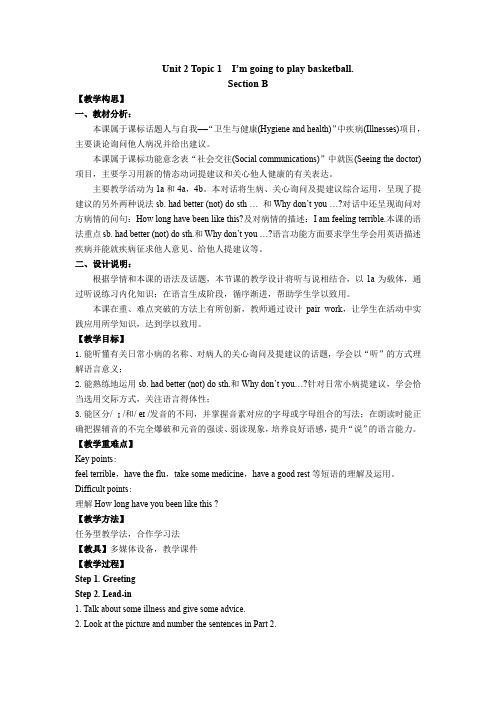
Unit 2 Topic 1 I’m going to play basketball.Section B【教学构思】一、教材分析:本课属于课标话题人与自我——“卫生与健康(Hygiene and health)”中疾病(Illnesses)项目,主要谈论询问他人病况并给出建议。
本课属于课标功能意念表“社会交往(Social communications)”中就医(Seeing the doctor)项目,主要学习用新的情态动词提建议和关心他人健康的有关表达。
主要教学活动为1a和4a,4b。
本对话将生病、关心询问及提建议综合运用,呈现了提建议的另外两种说法sb. had better (not) do sth … 和Why don’t you …?对话中还呈现询问对方病情的问句:How long have been like this?及对病情的描述:I am feeling terrible.本课的语法重点sb. had better (not) do sth.和Why don’t you …?语言功能方面要求学生学会用英语描述疾病并能就疾病征求他人意见、给他人提建议等。
二、设计说明:根据学情和本课的语法及话题,本节课的教学设计将听与说相结合,以1a为载体,通过听说练习内化知识;在语言生成阶段,循序渐进,帮助学生学以致用。
本课在重、难点突破的方法上有所创新,教师通过设计pair work,让学生在活动中实践应用所学知识,达到学以致用。
【教学目标】1.能听懂有关日常小病的名称、对病人的关心询问及提建议的话题,学会以“听”的方式理解语言意义;2.能熟练地运用sb. had better (not) do sth.和Why don’t you…?针对日常小病提建议,学会恰当选用交际方式,关注语言得体性;3.能区分/ ɪ/和/ eɪ /发音的不同,并掌握音素对应的字母或字母组合的写法;在朗读时能正确把握辅音的不完全爆破和元音的强读、弱读现象,培养良好语感,提升“说”的语言能力。
仁爱版八年级英语上册Unit2Topic2SectionB教学设计
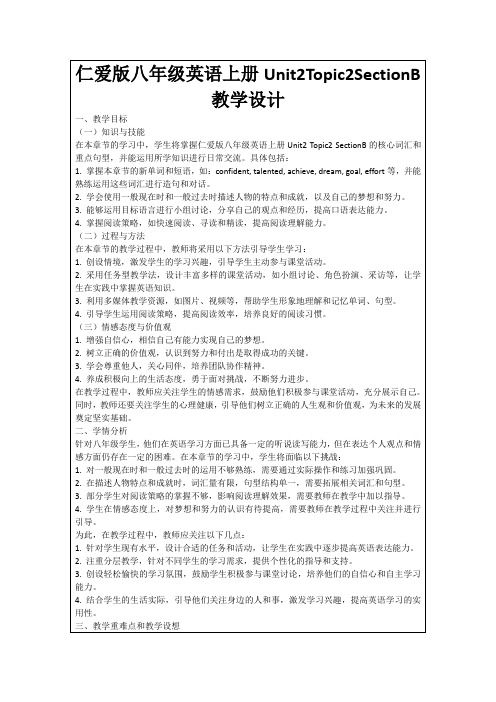
3.学会尊重他人,关心同伴,培养团队协作精神。
4.养成积极向上的生活态度,勇于面对挑战,不断努力进步。
在教学过程中,教师应关注学生的情感需求,鼓励他们积极参与课堂活动,充分展示自己。同时,教师还要关注学生的心理健康,引导他们树立正确的人生观和价值观,为未来的发展奠定坚实基础。
2.采用任务型教学法,设计丰富多样的课堂活动,如小组讨论、角色扮演、采访等,让学生在实践中掌握英语知识。
3.利用多媒体教学资源,如图片、视频等,帮助学生形象地理解和记忆单词、句型。
4.引导学生运用阅读策略,提高阅读效率,培养良好的阅读习惯。
(三)情感态度与价值观
1.增强自信心,相信自己有能力实现自己的梦想。
2.学生分享自己的观察和想法,教师适时总结并引出本节课的主题:“Today, we will learn how to describe the qualities and achievements of successful people in English.”
3.利用头脑风暴活动,让学生列举描述人物特点和成就的词汇,如confident, talented, achieve, dream, goal, effort等,为接下来的学习做好词汇准备。
4.作业完成后,学生要认真检查,确保无误,按时提交。
3.教师挑选几个小组进行展示,对学生的表现给予肯定和鼓励,同时指出需要改进的地方。
(四)课堂练习
1.教师设计一些练习题,如填空、选择、改错等,让学生巩固本节课所学的词汇和句型。
2.学生完成练习题后,教师及时批改并反馈,针对共性问题进行讲解。
3.鼓励学生互相讨论、纠错,提高他们的自主学习能力。
仁爱版八年级英语上册UNIT1TOPIC1SectionB教案

1 / 4UNIT 1 Playing SportsTOPIC 1I'm going to play basketball.Section B 教案教学重点1.在实际情景中运用型What are you going to be?I am going to be an artist/ a cook/ a doctor.What is your favorite sport? / I like…2.知道各种职业的说法。
教学难点重难点句型:(1)- What are you going to be when you grow up? - I am going to be an artist (2)- What is your favorite sport? - I like football. 教具准备(1)各种职业照片(2)教学PPT 教学过程热身/复习(Warm-up/Revision)1. Greetings and free talkT: Hello, boys and girls. How are you?2 / 4S: Hello, Miss. I'm fine, thank you, and you?T: I'm fine, too. Thank you very much.(Say hello to the teachers together)T: Before our class, let's enjoy a wonderful song, and we can relax. 通过一首歌曲使本课在轻松愉快的气氛下开始,同时教师通过歌曲提问顺利引入新课。
呈现新课1. Lead in.T: What a wonderful song! That sounds great. Do you know who sings the song? Ss: …T: Yes, you are right. XXX is a famous singer, and there is another famous person, I think maybeyou know him. What is your favorite activity?Ss: I like play basketball after school. T: That's great! Show the picture of Yao Ming.T: He is Yao Ming, he is a basketball player. Singer and basketball player are jobs. Now there aremany other jobs, do you want to know what they are?Ss: Yes.T: OK, I will show you.Show many pictures. Let students talk about what they are, then check them. T: Do you know what else jobs? Ss: …T: Today I want to show you other two jobs, they are player and teacher. 2. New knowledge.3 / 4Show the pictures of player and teacher.Students read the words follow the teacher. Read the words one by one. T: Do you want to be a player? Ss: …T: Do you want to be a teacher? Ss: …T: I am going to be a player. I am going to be a teacher. Write on the blackboard.Students follow the teacher to read the sentences. 3. Ask and answerT: They are both good jobs, but I think maybe in the future, you will be only one of them, soplease tell me, what are you going to be when you grow up?Ss: I am going to be a pilot. T: That sounds great. Ask and answer one by one.According to the students' answer, the teacher gives a question. T: Good. XXX says he/she wants to be a ...but do you know what things ...should do? Ss: ...T: Yes, you are right. Well (I)thinkteacherscan do so many things, let's have a look. Show thepictures.T: The teachers can design a class, learn knowledge and play with children. Look. Wow, that'sfantastic.Students repeat.T: OK, now please tell me, what are you going to be when you grow up?4 / 4Ss: …Write on the blackboard. Read the sentences. Make a dialog. Show some pairs.T: Your dreams are very great. I think everybody has a dream, so our friends—Michael and Mariahave dreams, too. Do you want to know what they want to be? You can guess. Ss: …T: Are you right or wrong? Let's read the dialog and find the answers.Listen to the tape and repeat twice. Students ask them then check the answers. 通过图片以及多媒体给学生直观的感受,使学生能迅速明白词义和句意,并通过多种形式进行操练,使学生对新授知识逐渐熟练并能相互交流。
仁爱版八年级英语上册全册教学设计全套教案
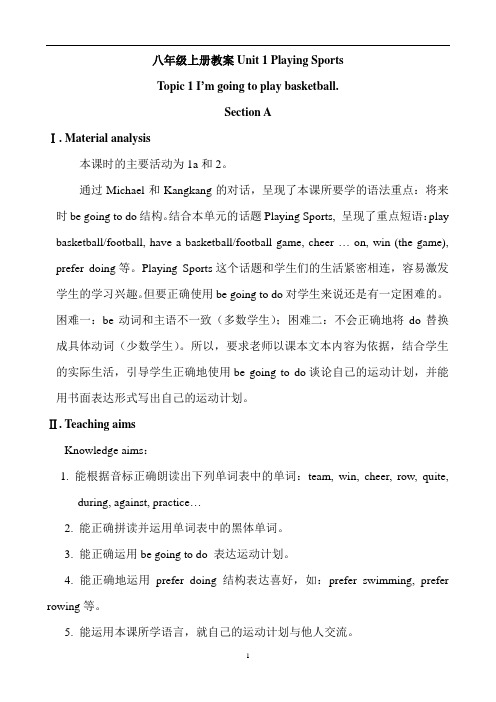
八年级上册教案Unit 1 Playing SportsTopic 1 I’m going to play basketball.Section AⅠ. Material analysis本课时的主要活动为1a和2。
通过Michael和Kangkang的对话,呈现了本课所要学的语法重点:将来时be going to do结构。
结合本单元的话题Playing Sports, 呈现了重点短语:play basketball/football, have a basketball/football game, cheer … on, win (the game), prefer doing等。
Playing Sports这个话题和学生们的生活紧密相连,容易激发学生的学习兴趣。
但要正确使用be going to do对学生来说还是有一定困难的。
困难一:be动词和主语不一致(多数学生);困难二:不会正确地将do替换成具体动词(少数学生)。
所以,要求老师以课本文本内容为依据,结合学生的实际生活,引导学生正确地使用be going to do谈论自己的运动计划,并能用书面表达形式写出自己的运动计划。
Ⅱ. Teaching aimsKnowledge aims:1. 能根据音标正确朗读出下列单词表中的单词:team, win, cheer, row, quite,during, against, practice…2. 能正确拼读并运用单词表中的黑体单词。
3. 能正确运用be going to do 表达运动计划。
4. 能正确地运用prefer doing结构表达喜好,如:prefer swimming, prefer rowing等。
5. 能运用本课所学语言,就自己的运动计划与他人交流。
Skill aims:1. 能听懂有关运动计划和运动爱好的简单对话和陈述。
2. 能正确地口头表达有关运动计划和运动爱好的话题。
八年级英语仁爱版上册Unit2_Topic2_SectionB优质课教案

Unit2 Topic2 SectionB优质课教案主讲教师:林海燕指导教师:林晴晖I. Material analysis:本课时的主要活动为1a, 3a和3b。
本课就吸烟这个坏习惯展开讨论,呈现了本单元语法重点:情态动词must+动词原形:I must ask him to give up smoking.表示建议、劝告。
同时巩固了动名词做主语的句式:Smoking is bad for his health.通过学习Section B,让学生能够辨别好习惯与坏习惯,并能帮助亲人戒掉坏习惯。
课后要求学生会用动名词做主语造句,能用must提建议。
Ⅱ. Teaching aims and demands1. New wordsarticle, smoke, cancer, even, energy, necessary, active2. Phrasesread in the sun, be bad for…, an article about smoking, in the newspaper, help him relax,the article says, cause cancer, ask sb. to do sth., give up sth./doing sth., show sth.to sb.3. Useful expressions(1)I'm reading an article about smoking in the newspaper.(2)He thinks smoking can help him relax.(3)The article says smoking is bad for our lungs and it can even cause cancer.(4)I must ask him to give up smoking.4. Modal verbmust and mustn’t5. Skill aims(1)Talk about good habits and bad habits.(2)Learn to use modal verb must and mustn’t correctly.(3)Learn to use intonation to read the dialogue correctly.6. Emotional aims:Learn to keep good habits and give up bad habits.Ⅲ. The key points and difficult points1. Key points(1)Learn to use modal verb must and mustn’t correctly.(2)I must ask him to give up smoking.2. Difficult pointsLearn to use gerund as subject correctly.Ⅳ. Learning strategies1.通过图片教学和句子翻译记忆词汇。
仁爱版八年级英语上册Unit2Topic1.SectionB教学设计
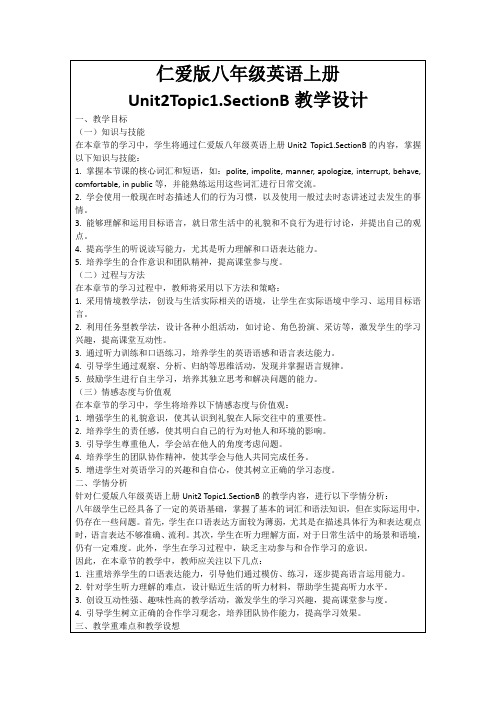
-教师给予反馈、指导,帮助学生查漏补缺。
(五)总结归纳
1.教学活动设计:
-教师引导学生回顾本节课所学内容,总结知识点。
-学生分享学习收获,教师给予评价、鼓励。
2.教学目标:
-帮助学生巩固所学知识,形成知识体系。
-提高学生的学习自信心,激发学习兴趣。
3.教学过程:
2.学会使用一般现在时态描述人们的行为习惯,以及使用一般过去时态讲述过去发生的事情。
3.能够理解和运用目标语言,就日常生活中的礼貌和不良行为进行讨论,并提出自己的观点。
4.提高学生的听说读写能力,尤其是听力理解和口语表达能力。
5.培养学生的合作意识和团队精神,提高课堂参与度。
(二)过程与方法
在本章节的学习过程中,教师将采用以下方法和策略:
-教师引导学生回顾本节课所学词汇、语法、听力等知识点。
-学生分享学习收获,教师给予积极评价、鼓励。
-布置课后作业,为下一节课的学习做好铺垫。
五、作业布置
针对仁爱版八年级英语上册Unit2 Topic1.SectionB的教学内容,以下为作业布巩固所学词汇、语法知识。
-引导学生从文化角度认识礼貌行为的重要性,培养其良好的跨文化交际能力。
四、教学内容与过程
(一)导入新课
1.教学活动设计:
-利用图片、视频等多媒体资源,展示日常生活中礼貌和不良行为的场景,引导学生关注和思考。
-邀请学生分享自己在生活中遇到的不礼貌行为及感受,激发学生对本节课主题的兴趣。
2.教学目标:
-引起学生对礼貌行为的关注,激发学习兴趣。
4.鼓励学生互相交流、讨论,共同完成作业,培养合作精神。
-通过小组讨论,让学生分享自己遇到的不礼貌行为及感受,激发学生的学习动机。
仁爱英语八年级上册unit2-topic1-Section-C精品公开课教案设计

视频激趣-阅读技巧和语言知识处理-阅读训练-游戏激趣-写作拓展-课堂小结-作业布置
七、教学方法(Teaching Methods)
以学生为中心,利用任务教学方法,引导学生掌握阅读技巧。再通过复述、表演故事及写作等活动,让所有学生参与到学习中来,通过听、说、读、写的训练达到提升学生综合运用语言的目的。
请你分析一下这篇文章的题材、人称和时态。
设计目的:以游戏的形式复习巩固,承上启下,再次激发学生的学习兴趣。
2.Writing
T:How can we write it?
设计目的:分析题目,指导写作方法。
T: Write it on your paper.
设计目的:在思维导图的引领下,培养学生写作布局意识和连贯语言表达技巧,搭建写作结构和写作思维框架,做出切实有效语言输出,将本课所学灵活运用到写作当中,以此提高写作能力。
二、While-reading
T:According to the picture we can know Michael was hurt when he played skateboard. Let’s know more information about the story . Please scan the passage and finish this task .
阅读理解能力和自主合作和探究的能力。但很多学生还是对阅读理解感到厌烦甚至畏惧。为此,课堂上设置了多元化阅读题型,以充分调动学生的阅读积极性。
三、教学目标(Teaching aims)
1.知识目标(Knowledge aims)
(1)Use the words “should、had better and need to” to give advice.
仁爱英语(新)八年级上unit2topic2sectionb优秀教学案例

本环节通过展示一段关于学生们日常活动的视频,激发学生的学习兴趣,引导学生思考和讨论他们自己的日常活动。教师通过提问方式引导学生回顾上一节课的内容,为新课的学习做好铺垫。
(二)讲授新知
本环节主要讲解一般现在时的用法和动词短语的描述日常活动。教师通过生动的语言和示例,让学生理解一般现在时的概念和用法,并通过互动方式,让学生积极参与,巩固所学知识。同时,教师引导学生运用动词短语描述自己的日常活动,提高他们的语言运用能力。
仁爱英语(新)八年级上unit2topic2sectionb优秀教学案例
一、案例背景
本案例背景以“仁爱英语(新)八年级上Unit2 Topic2 Section B”为主题,旨在通过深入挖掘课本内容,结合学科特点,设计出一堂既实用又有趣的教学课堂。本节课主要围绕“询问时间和谈论日常活动”的话题展开,通过学习本节课,学生能够掌握一般现在时的运用,灵活运用动词短语描述日常活动,并能够询问他人的日常安排。在教学过程中,教师需要充分考虑学生的认知水平和生活经验,通过创设真实的生活情境,激发学生的学习兴趣,提高他们的语言运用能力。同时,教师还需注重培养学生的合作意识,让他们在小组活动中相互交流、共同进步。
4.反思与评价:教师引导学生对课堂教学进行反思,总结学习收获,提高了学生的自我评价能力。同时,学生之间的互评和教师的评价,使得学生能够更好地了解自己的不足,提高了学生的综合素养。
5.教学方法多样:本节课采用了情境教学法、任务型教学法、交际式教学法等多种教学方法,丰富了教学手段,激发了学生的学习兴趣。教师注重个体差异,因材施教,使得每个学生都能在课堂上得到充分的锻炼。
(五)作业小结
本环节教师布置作业,让学生运用所学知识,完成相关的练习题。作业包括填写时间表格、用动词短语描述日常活动等,让学生在课后巩固所学知识,提高他们的实践能力。同时,教师鼓励学生在课后主动与同学交流,分享学习心得,培养他们的合作意识。
仁爱版英语八年级上册UNIT 1 TOPIC 2 Section B 教案

UNIT 1 Playing SportsTOPIC 2 I’ll kick you the ball again.Section B教案一、教学目标1. 认知目标:学习含有“ight”与“y”的单词,注意发音的区别;复习上节课所学的词汇与句型,将所学知识更好的与生活实践结合。
复习并熟练掌握句型:What sports does he / she love? ,以及回答:He / She loves.... ;句型:Does he / she love ...? ,以及回答:Yes, he / she does. & No, he / she does n’t.2. 能力目标:能运用所学句型与同学交流喜欢的体育运动并学会用英语和别人道歉,将所学运用到生活中。
3. 情感目标:让学生通过对课文内容的学习掌握,增强学习的信心,调动学生的学习兴趣。
二、教学重难点1. 重点能运用所学句型与同学交流喜欢的体育运动,将所学运用到生活中。
2. 难点句型:I will kick you the ball again;句型:I am sorry for that,以及回答it’s nothing. 的理解掌握。
三、教学用具多媒体教学设备、单词卡片。
四、教学设计Step 1 warming1. 师生互相问好。
师:Good morning, class! Nice to see you again.生:Good morning, ***! Nice to see you, too!2. 教师要求大家一起说出所学过的一些体育运动。
教师询问同学通过前两课的学习是否已经对体育运动有所了解了?是否希望有进一步的学习?Step 2 Revision and Presentation1. 教师告诉学生我们这节课要进一步学习如何用英语与同学交流体育运动,将学到的句型运用到生活中。
2. 教师请学生简要介绍自己及家人喜欢的体育运动。
仁爱版英语八年级上册Unit1_Topic1_SectionB优质课教案

Unit1 Playing sportsTopic1 I’m going to play basketball.SectionB 优质课教案I. Material analysis本节课是八年级上册第一单元第一个话题的Section B本课重点活动是1a、1c和1d。
学生通过谈论自己最爱的运动、运发动以及梦想职业,进一步了解一般将来时be going to的用法。
同时通过对梦想职业的向往,鼓励学生努力学习,互相帮助,实现梦想。
Ⅱ. Teaching aims1. Knowledge aimsJobs: Scientist, musician, pilot, policeman, Policewoman, postman, fisherman Phrases: grow up, in the futureNew sentences:(1) —What are you going to be when you grow up?—I’m going to be a...(2) —What’s your favorite sport, Maria?—Basketball, of course.(3〕—Who’s your favorite player?—LeBron James.Go on learning future tense with “be going to + do〞:2. Skill aimsTalk about the favorite sports, players and dream jobs.3. Emotional aimsEncourage students to study hard and help each other to achieve their dreams.Ⅲ. The key points and difficult points1. Key pointsUse the target language correctly.2. Difficult pointsUse “be going to〞to describe their dream jobs correctly.Ⅳ. Teaching aids多媒体,图片,卡纸,便签纸。
仁爱版八年级英语上册Unit1Topic2SectionB教案

八年级上册教案设计Unit 1 Playing SportsTopic 2 We should learn teamwork.Section BⅠ. Material analysisSection A and Section B 的内容整合,用三个课时上完。
本节课为单元第二课和第三课时,用两课时上完,主要活动为Section B 的1a和4a, 4b。
通过Maria和Jane平息Kangkang和Michael的争吵,呈现了对话的主题是:One player doesn’t make a team. 对话呈现了提建议的三种方式:(1)祈使句的肯定句、否定句形式;(2)What about doing sth?(3)sb should do sth.语音学习:(1)让学生区分元音/ e / 和/ @/ 发音的不同,并能掌握各自的拼写规则。
(2)让学生体会清辅音的不完全爆破并能正确朗读。
本课帮助学生学会请求、提建议、道歉的表达法,通过和他人的沟通、合作,将团队合作精神融于对话中。
要求学生能结合学过的be going to do,进一步谈论有关自己最喜欢的运动的话题,并能将团队合作精神体现在书面表达中。
Ⅱ. Teaching aimsKnowledge aims:1. 能区分元音音素/e/和/}/的发音,并能正确拼读单词,注意对应的字母组合的拼写规则;能在句中正确朗读辅音的不完全爆破。
2. 能正确拼读并运用单词表中的单词: fight, angry, nothing, finish, grandfather.3. 能正确运用以下短语造句:shout at sb, do one’s best, be angry with sb, talk about sth, keep doing sth.4. 能自如地运用以下功能性语言进行交流,表达提建议、道歉:Don’t shout at me like that.Please don’t fight.You should learn teamwork.What about saying sorry to Michael?I am sorry for what I said.It’s nothing.5. 能对双宾结构进行句型转换,理解并能运用双宾语结构。
仁爱版八年级英语上册Unit1 Topic2 Section B 教案设计

Unit1 Topic2 Section B 优质课教案(湖北省)一、教学目标1. Learn some new words and phrases: fight, teamwork, angry, nothing, throw, shout at sb do one’s best, be angry with sb.2. Learn some functional sentences to make apologize and response, such as:I’m sorry for what I said.It’s nothing.3. Learn to value the friendship and realize the importance of teamwork.二、学情分析这篇课文为新学期开学后的第二个话题而且是关于学生喜欢的运动的内容所以大多数学生比较有学习的兴趣和求知欲三、重点难点1. use the verb to make phrases2. learn how to make apologize to others and response.四、教学过程4.1第一学时4.1.1教学活动活动1【导入】Step1 Lead in1. Show students the learning aims and demands.2. Ss learn new words by themselves first then use the team competition to learn and remember new words… Next, follow teacher to read, and play a game3. Share an essay about friends with students Then talk about friends.4. Lead in Kangkang and Michael in this lesson by learning new phrases.活动2【讲授】step2 Presentation1. Listen to 1a and answer a question.2. Watch the flash and mark T or F.3. Read and act to continue competition.活动3【活动】Step3 Consolidation1. Read 1a and fill in the blanks.2. Then retell the story after some key words.3. Enjoy a beautiful song about friendship to realize we should value our friends.活动4【练习】Step4 Summary1. Review the words and phrases Ss have learned today.2. Sum the results of compition. Prize the winner team.。
仁爱版英语八年级上册Unit 2 Topic 1 Section B教案

1.She feels like running.她想要去跑步。
She ____ ___________.(同义转换)
2..我不想吃东西。
I ______ feel ___________.
3.You'd better tell him about it(改否定句).
You'd better _____ ______ him about it.
10.Iam feeling terrible.
11. sb. had better (not) do sth
12.Whydon’tyou…?
12.sb. had better (not) do sth
13.Whydon’tyou…?
目标
3:能够说出时间状语从句的结构及用法,并能熟练做题。
当堂训练:
1.take care of
3.need to
4.take pills
5.help sb (to) do
6.How long have been like this?
7.Iam feeling terrible.
8 sb. had better (not) do sth
9. Whydon’tyou…?
7. had better do
You had better go to see a doctor.
8. shouldn’t do
You shouldn’t eat too much candy.
9. had better not do
You’d better not work too long.
9.How long have been like this?
八年级英语上册Unit2Topic1YoushouldbrushyourteethtwiceadayPeriod4教学案例设计(新版)仁爱版
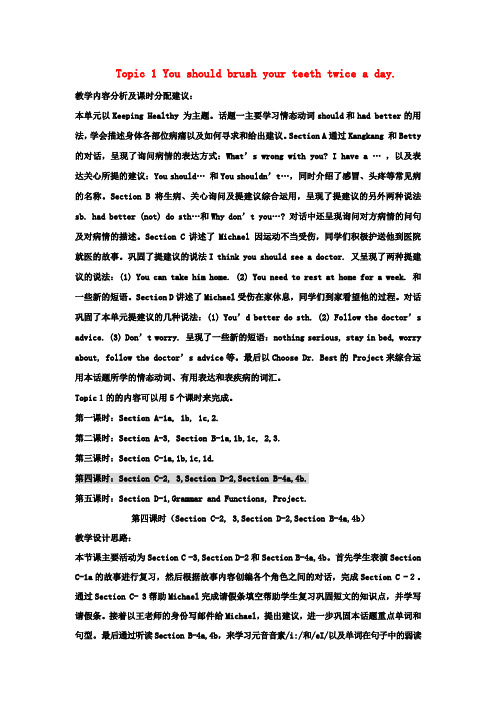
Topic 1 You should brush your teeth twice a day.教学内容分析及课时分配建议:本单元以Keeping Healthy 为主题。
话题一主要学习情态动词should和had better的用法,学会描述身体各部位病痛以及如何寻求和给出建议。
Section A通过Kangkang 和Betty 的对话,呈现了询问病情的表达方式:What’s wrong with you? I have a …,以及表达关心所提的建议:You should…和You shouldn’t…,同时介绍了感冒、头疼等常见病的名称。
Section B将生病、关心询问及提建议综合运用,呈现了提建议的另外两种说法sb. had better (not) do sth…和Why don’t you…? 对话中还呈现询问对方病情的问句及对病情的描述。
Section C讲述了Michael 因运动不当受伤,同学们积极护送他到医院就医的故事。
巩固了提建议的说法I think you should see a doctor. 又呈现了两种提建议的说法:(1) You can take him home. (2) You need to rest at home for a week. 和一些新的短语。
Section D讲述了Michael受伤在家休息,同学们到家看望他的过程。
对话巩固了本单元提建议的几种说法:(1) You’d better do sth. (2) Follow the doctor’s advice. (3) Don’t worry. 呈现了一些新的短语:nothing serious, stay in bed, worry about, follow the doctor’s advice等。
最后以Choose Dr. Best的 Project来综合运用本话题所学的情态动词、有用表达和表疾病的词汇。
仁爱版英语八年级上册UNIT 2 TOPIC 1 Section B 教案
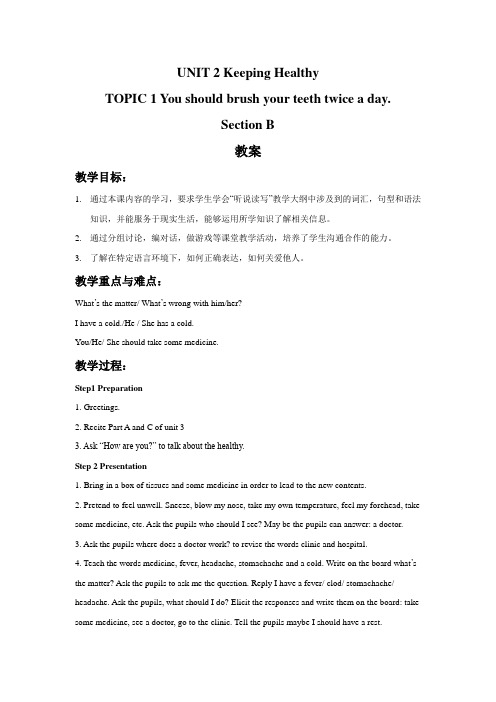
UNIT 2 Keeping HealthyTOPIC 1 You should brush your teeth twice a day.Section B教案教学目标:1.通过本课内容的学习,要求学生学会“听说读写”教学大纲中涉及到的词汇,句型和语法知识,并能服务于现实生活,能够运用所学知识了解相关信息。
2.通过分组讨论,编对话,做游戏等课堂教学活动,培养了学生沟通合作的能力。
3.了解在特定语言环境下,如何正确表达,如何关爱他人。
教学重点与难点:What’s the matter/ What’s wrong with him/her?I have a cold./He / She has a cold.You/He/ She should take some medicine.教学过程:Step1 Preparation1. Greetings.2. Recite Part A and C of unit 33. Ask “How are you?” to talk about the healthy.Step 2 Presentation1. Bring in a box of tissues and some medicine in order to lead to the new contents.2. Pretend to feel unwell. Sneeze, blow my nose, take my own temperature, feel my forehead, take some medicine, etc. Ask the pupils who should I see? May be the pupils can answer: a doctor.3. Ask the pupils where does a doctor work? to revise the words clinic and hospital.4. Teach the words medicine, fever, headache, stomachache and a cold. Write on the board what’s the matter? Ask the pupils to ask me the question. Reply I have a fever/ clod/ stomachache/ headache. Ask the pupils, what should I do? Elicit the responses and write them on the board: take some medicine, see a doctor, go to the clinic. Tell the pupils maybe I should have a rest.Demonstrate by putting my head on my arms on the desk. Add have a rest to the phrases on the board.5. Point to the dentist in the picture. Tell the pupils that dentists look after our teeth. Ask the pupils who visits the dentist? Those who visit the dentist should raise their hands.6. Ask the pupils to read the dentist’s advice aloud. Ask the pupils to point to the correct parts of the teeth on the pictures.7. Play the cassette for the pupils and ask them to say the sentences after the speaker.8. Ask the pupils what should we eat? and What shouldn’t we eat?Learn to distinguish healthy food for our teeth.Step 3 Revision1. Show the flashcards, review this unit.2. Have a dictation.3. Show the courseware, ask the pupils to read silently what doctor say.4. Show the pupils the close-up picture of the doctor’s notes. Play the cassette, ask the pupils to read the conversation aloud.5. Check the pupils know what advice the doctor has given. Ask them to write it in the blanks on the doctor’s note. Explain that we often give advice using should and need to.6. Play the cassette again and ask the pupils to check their work.Step 4 Have fun1. Play a guessing game. (look at the teacher’s gesture carefully, and give the correct name of ill. Then invite the other pupils instead of teacher.)2. Read the text together.Homework1. Copy the new words of this unit each four times.2. Finish the exercises in Koko Homework.3. Retell the story to the parents at home.。
仁爱版英语八年级上二单元一话题集体备课

课程标准要求
能在听读看的过程中,围绕语篇内容记录重点信息,整体理解和简要概括主要内容;能根据听到或读到的关键词对人物、地点、事件等进行推断;能根据读音规则和音标拼读单词;能分析和梳理语篇结构。
学习目标
学生通过改述、课堂学习以及练习的方式掌握情态动词should和shouldn’t的用法以及转换,能明确给出建议。
教学方法:3P教学法
教学流程:
一、导入:If your friendsfell down, what do you want to do for them? Do youremembersomething about mistakes in your daily life?
二、读前(Pre-reading)
授课内容
Unit 2Topic1Section D
授课教师
一、学习目标:1.能正确运用本单元所学内容、比较流利对同学表达关心建议。
2. 能阅读有关疾病的文章,理解文章大意,并能做出相关的阅读练习
3. 能综合运用本单元的语法、词汇、句型写出对同学的关心,并且能够写信表达自己对疾病的建议。
二、 知识目标:能正确拼读并运用单词表中的单词和短语
话题分析
话题教材分析
本话题属于“人与社会”这一主题,围绕健康这一核心,向学生介绍了疾病,健康习惯,流感等相关内容,以及如何处理在活动中生病了之后如何处理。
话题知识分析
学习关于疾病的单词,运用情态动词should和shouldn’t来提出建议,以及如何去描述疾病。
学情分析
学生以前除了上个话题得ill,完全没有接触过与疾病相关的内容;理解概括能力基本缺失。
三、素养目标:通过阅读,学生能够从中了解同学之间如何互相帮助,并且能够积累关于说明写作的相关内容,为以后的书写打下揭示的基础。
仁爱版八年级英语上册Unit2Topic1SectionB教学设计

c.学生进行时态转换练习,巩固知识。
(三)学生小组讨论
1.教师将学生分成小组,每组根据提供的情境,讨论如何用一般现在时态描述人物特征和日常行为。
a.教师给每个小组发放一个情境卡片,要求学生讨论并编写对话。
b.学生在小组内部分工合作,共同完成对话编写。
c.教师巡回指导,给予建议和帮助。
5.每日一句:请用一般现在时态,编写一句关于人物特征或日常行为的句子,并在课后向家人或朋友展示。此举旨在培养学生的语言表达能力,并鼓励他们将英语应用到日常生活中。
作业提交方式:
1.编写的小故事和词汇练习题以书面形式提交。
2.口语练习视频以电子邮件或微信方式提交。
3.每日一句可拍照或文字形式在班级群分享。
2.词汇练习:完成课后词汇练习题,巩固所学词汇。学生需注意单词的拼写、词义理解和词汇运用,提高词汇量。
3.口语练习:与同学合作,进行角色扮演,模拟本节课所学的对话情境。要求学生尽量使用一般现在时态,进行流畅、自然的口语表达。家长可协助录制视频,教师将对学生的口语表现进行评价和指导。
4.听力练习:完成课后听力练习,提高听力理解能力。学生需关注关键信息,锻炼听力技巧,提高获取和处理信息的能力。
a.学生总结所学知识,分享学习心得。
b.教师提问:“What have we learned today?”
c.学生回答问题,教师给予肯定。
2.教师布置课后作业,要求学生运用所学知识编写一个关于人物特征和日常行为的小故事。
a.学生明确作业要求,注意故事的结构和语言表达。
b.教师提醒学生按时完成作业,巩固所学知识。
(三)情感态度与价值观
1.培养学生尊重他人、礼貌待人的品质,使他们意识到文明礼貌在人际交往中的重要性。
仁爱版八年级上Unit1 Topic 2 Section B教案
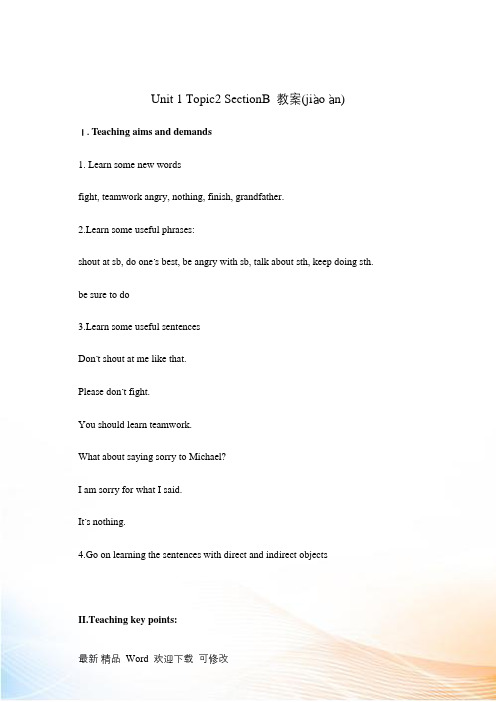
Unit 1 Topic2 SectionB 教案(jiào àn)Ⅰ. Teaching aims and demands1. Learn some new wordsfight, teamwork angry, nothing, finish, grandfather.2.Learn some useful phrases:shout at sb, do one’s best, be angry with sb, talk about sth, keep doing sth. be sure to do3.Learn some useful sentencesDon’t shout at me like that.Please don’t fight.You should learn teamwork.What about saying sorry to Michael?I am sorry for what I said.It’s nothing.4.Go on learning the sentences with direct and indirect objectsII.Teaching key points:1.The expressions for making suggestions:inperative sentences Don’t shout at me like thatWhat about doing…Sb. should do sth.2.To understand and paraphrase the sentences with direct and indirect objects III. Teaching difficult points:1.Understand“what” in be sorry for what I said2.Retell 1a in Section BIV .Teaching aidsTape recorder multi-mediaV. Teaching proceduresStep 1 Revision1.Revise Would you mind doing…by praticing 2 in Section A .Get the students to look atthe picture in 2 ask and answer without looking at the book.2.Get some students to something about in 1a in SectionA .(1)Kangkang and his team are going to have a soccer game against Class Five on Saturday.(2)But one of his teammate fell ill .So Kangkang asks Michael to join them.(3)Michael is not good at playing soccer, so Michael and Kangkang are practicing it . Step 2 Presentation1.To learn the new words in 1a.(1)T:Look at the boy .He is Li Lei .He is unhappy. Li Lei did his best to study hard, bu t he didn’t pass the exam. His father is angry with him.His mother is shouting at him.(2)T:Now look at the picture in 1a .What are kangkang and Michael doing?Ss:They are fighting .T:Can you guess why they are fighting .S1:I think they didn’t win the game.T:ok,let’s listen to 1a and find the answer.2.Listen to 1a and check the answer.3.Get the students to read the statements in 1b and predict whether they are trueandfalse.Then finish 1b.Step 3 Consolidation1Listen to 1a and read after the recording,pay attention to the pronunciation.2.Read an act out the dialogue.3.Get the students to find out the key points(1)shout at(2)Please don’t fight(3)do one’s best(4)You should learn teamwork(5)be angry with(6)What about saying sorry to Michael.(7)-I’m sorry for what I said .-It’s noting(8)keep trying .(9)be sure to do sth.(10)talk about(11)with the help of(12)have fun4.Finish 1c and retellStep 4 Practice1.Finish2.2.Finish3. Teacher lets the students observe the structure of the example and paraphrase the sentences in 3.3.Ask students to read 4a word by word. Teacher shows phonetic cards/e/ and /ai/. Ask the students to read /e/ and /ai/ one by one.4.Read 3bStep 5 Project1.sum upPhrases and sentences(1)shout at(2)Please don’t fight(3)do one’s best(4)You should learn teamwork(5)be angry with(6)What about saying sorry to Michael.(7)-I’m sorry for what I said .-It’s noting(8)keep trying .(9)be sure to do sth.(10)talk about(11)with the help of(12)have funthe sentences with direct and indirect objects2.Homework(1)Finish exercise in the workbook(2)Retell 1a .WritingTopic 2 SectionBfight be angry with Don’t shout at me like that.teamwork do one’s best Please don’t fightnothing talk about You should learn teamwork.finish What about saying sorry to Michael?grandfather I’m sorry for what I said.It’s nothing.内容总结。
- 1、下载文档前请自行甄别文档内容的完整性,平台不提供额外的编辑、内容补充、找答案等附加服务。
- 2、"仅部分预览"的文档,不可在线预览部分如存在完整性等问题,可反馈申请退款(可完整预览的文档不适用该条件!)。
- 3、如文档侵犯您的权益,请联系客服反馈,我们会尽快为您处理(人工客服工作时间:9:00-18:30)。
仁爱版精品英语资料(精校版)
八年级上册教案设计
Unit 2 Keeping Healthy
Topic 1 You should brush your teeth twice a day.
Section B
Ⅰ. Material analysis
本节课的主要活动为1a,4a和4b。
本课时将生病、关心询问及提建议综合运用,呈现了提建议的另外两种说法sb. had better (not) do sth…和Why don’t you…? 对话中还呈现询问对方病情的问句:How long have been like this? 及对病情的描述:I am feeling terrible. 本课的语法重点sb. had better (not) do sth 和Why don’t you…? 语言功能方面要求学生学会用英语描述疾病并能就疾病征求他人意见、给他人提建议等。
课后要求学生能用英语写一篇描述疾病并提出有益建议的文章。
Ⅱ. Teaching aims
Knowledge aims:
1. 能正确运用以下短语进行书面表达:feel terrible, have the flu, take some medicine, have
a good rest等。
2. 能正确地运用sb. had better (not) do sth 和Why don’t you…? 提建议。
Skill aims:
1. 能区分/1/和/eI/发音的不同,并掌握音素对应的字母或字母组合的写法;在
朗读时能正确把握辅音的不完全爆破和元音的强读、弱读现象。
2. 能听懂有关日常小病的名称、对病人的关心询问及提建议的话题。
3. 能熟练地运用sb had better (not) do sth 和Why don’t you…? 针对日常小病提建议。
Emotional aims:
通过语言学习,影响学生的自身品格,要学会信任他人、关心他人,为我们的健康生活营造友爱、和谐的氛围。
Ⅲ. The key points and difficult points
Key points:
feel terrible, have the flu, take some medicine, have a good rest等短语的理解及运用。
Difficult points:
理解How long have you been like this ?
Ⅳ. Learning strategies
1. 巩固学生根据图片猜单词意思的能力。
2. 巩固学生模仿已有例句造句的能力。
Ⅴ. Teaching aids
Computer multimedia projector, chalk, blackboard
Everyday saying: Bitter pills may have wholesome effects. 良药苦口利于病。
Ⅵ. Teaching procedures
Ⅶ. Blackboard design。
